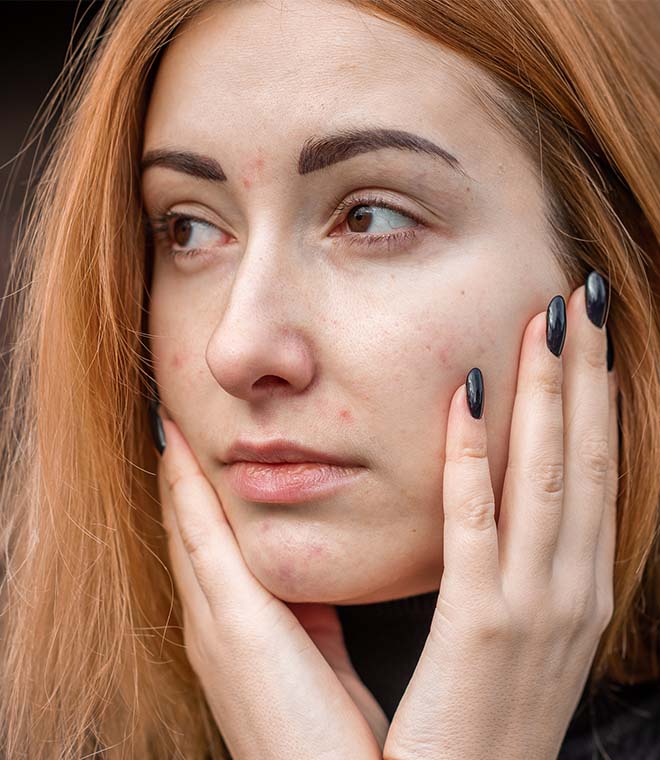Health
What is Comedonal acne?
By Dr. Anna H. Chacon, MD, Fellow of the American Academy of Dermatology Apr 03, 2024 • 4 min
Comedonal acne is one of the most common types of acne, and while anyone of any age can experience this skin issue, it’s most common among teenagers. Comedonal acne may cause embarrassment and frustration, but treatment and preventive measures can help you achieve clear skin.
What is a comedone?
Comedones are skin-colored, small lesions (bumps) often found on the chin or forehead. A single comedonal lesion is called a comedo, and it’s the result of a clogged pore.
Pores are tiny openings in the skin that contain a hair follicle and a sebaceous duct, which secretes an oil known as sebum. When the cells that line the sebaceous duct multiply, it causes an increase in the production of sebum. If debris like dirt, dead skin cells and the excess sebum get trapped in the pore, it forms a bump—or comedo.
What is comedonal acne?
One of the most common types of acne, comedonal acne is characterized by many comedones, which may occur in small or large numbers, most commonly on the forehead, cheeks and chin. In some cases, it’s triggered by biological or environmental influences like hormones or skin care products.
Symptoms of comedonal acne
The primary sign of comedonal acne is the development of numerous comedones on the skin. Different types of comedones have different appearances.
- Closed comedones, also known as whiteheads, form when the hair follicle is completely blocked with debris.
- Open comedones, also known as blackheads, form when a skin pigment called melanin collects in the clogged pores. Contrary to popular belief, it’s not dirt that causes the comedo to appear black, but rather the oxidation of melanin when it’s exposed to air.
- Microcomedones are very small papules that are difficult to see with the naked eye.
- Macrocomedones. Macrocomedones are closed comedones that are larger than one millimeter in diameter. They appear as a blackhead-like opening on the surface of the skin.
Treatments for comedonal acne
Options for treating comedonal acne include topical treatments, oral medications and minor surgical procedures.
Topical treatments for comedonal acne include:
- Benzoyl peroxide, commonly found in over-the-counter acne medications
- Azelaic acid, available over-the-counter in various strengths
- Salicylic acid, a type of beta hydroxy acid found in prescription and over-the-counter products
- Sulfur, available in both over-the-counter and prescription strengths
- Resorcinol, a powerful exfoliator that is typically used with sulfur, but rarely alone
- Glycolic acid, a type of alpha hydroxy acid commonly used in chemical peels
- Topical retinoids, including retinol, tretinoin and adapalene, which are available by prescription in various strengths
Oral medications used to treat comedonal acne include:
- Isotretinoin (such as Accutane)
- Hormone therapy involving oral contraceptives and/or spironolactone, a medication that reduces the hormones that may cause an overproduction of sebum
- Antibiotics, typically in the tetracycline category (like doxycycline) or the penicillin category (like amoxicillin)
Surgical treatments and procedures for comedone extraction include:
- Cryotherapy, which usually takes place in a dermatologist’s office and involves freezing lesions with liquid nitrogen to remove them
- Electrocauterization, which uses the heat from an electrical current to destroy abnormal tissue
How to prevent comedonal acne
While there’s no sure way to prevent comedonal acne, you can take steps to help minimize comedonal acne from occurring or recurring, including:
- Be gentle with your skin. Use mild cleansers, lukewarm water and a light touch
- Choose cosmetics and skin care products that are oil-free and labeled non-comedogenic, which means they don’t contain ingredients that can contribute to the development of comedones
- Shampoo your hair regularly, especially if you have oily hair
Comedonal acne is a common skin condition that most often affects teenagers, although anyone can develop the issue. The good news is that while there are many causes of comedonal acne, it is treatable. But since no two cases of comedonal acne are the same, treatment may require a period of time to find the treatment or combination of treatments that work for your acne and your skin, from topical and oral medications to comedones extraction.
If you think you might have comedonal acne, or you’ve tried unsuccessfully to treat it yourself, make an appointment with your dermatologist. Together, you can formulate a treatment plan and take action. With a little time and patience, you can send those comedones packing and create the framework for a lifetime of clear skin.
Clinically reviewed and updated April 2024.
Sources:
- https://medlineplus.gov/ency/article/003236.htm
- https://www.americanskin.org/resource/acne.php
- https://www.ncbi.nlm.nih.gov/books/NBK459173/
- https://www.aad.org/public/diseases/acne/skin-care
- https://www.ncbi.nlm.nih.gov/pmc/articles/PMC6273829
- https://www.uptodate.com/contents/acne-vulgaris-overview-of-management#H2104842286
- https://www.mayoclinic.org/drugs-supplements/resorcinol-topical-route/description/drg-20065777



